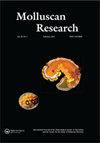镉诱导金属硫蛋白在不同器官中的性别差异
IF 0.6
4区 生物学
Q3 ZOOLOGY
引用次数: 0
摘要
摘要为了研究重金属对水生生物生理的影响,以往的研究主要集中在样品中选定的生物标志物的测量上。然而,大多数研究没有考虑到对男性和女性的毒性影响。本文旨在利用金属硫蛋白(MTs)研究性别对解毒反应的影响,金属硫蛋白是金属污染的生物标志物。对暴露于镉(Cd)环境下雌雄多纳猴(Donax trunculus L.,软体动物,Bivalvia)不同器官(套膜、消化腺和性腺)的MTs进行了测定。这些样本是在远离任何污染源的El Battah海滩收集的,并在实验室中饲养了四天。在饲养水中以先前确定的两种亚致死浓度(LC10和LC25)添加Cd。在(0、48和96 h)测量了mtts, Cd暴露在两性所有研究器官中都显著诱导了mtts (P < 0.05),其中雌性有显著影响。消化腺的MT含量最高,其次是性腺,然后是被膜。雌性和雄性个体对Cd的易感性存在差异。本研究支持性别和组织在生态毒理学研究中的重要性。关键词:生物标记,消化腺,雌性,雌性,重金属,小型软体动物。作者希望感谢匿名审稿人对本文的有益讨论和批判性阅读。本研究作为PRFU项目(Pr. N. Soltani)的一部分进行,并由分配给应用动物生物学研究实验室(Badji Mokhtar大学,安纳巴)的国家基金支持。披露声明作者未报告潜在的利益冲突。本文章由计算机程序翻译,如有差异,请以英文原文为准。
Sex-specific differences in metallothionein induction by cadmium in different organs of Donax trunculus Linnaeus, 1758
ABSTRACTTo investigate the impact of heavy metals on the physiology of aquatic organisms, previous studies have focused on selected biomarker measurements in samples. However, most studies do not take into account toxicity effects on both males and females. The present paper aims to examine the effect of sex on the detoxification response using metallothioneins (MTs), a biomarker of metallic contamination. MTs were measured in different organs (mantle, digestive gland and gonad) of both males and females of Donax trunculus L. (Mollusca, Bivalvia) exposed to cadmium (Cd). The samples were collected at El Battah beach, far from any source of pollution, and reared in the laboratory for four days. Cd was added to the rearing water at two previously determined sublethal concentrations (LC10 and LC25). Measurements of MTs were made at (0, 48 and 96 h). Cd exposure caused a significant induction (P < 0.05) of MTs in all studied organs in both sexes with a marked effect in females. The digestive gland had the highest MT levels, followed by the gonad and then mantle. Female and male individuals of this species differ in their susceptibility to Cd. This study supports the importance of sex and tissue in ecotoxicological studies.KEYWORDS: Biomarkerdigestive glandfemalegonadheavy metalsmalemantlemolluscs AcknowledgementsThe authors wish to thank anonymous referees for useful discussions and critical reading of the manuscript. This study was conducted as part of a PRFU project (Pr. N. Soltani), and was supported by the National Fund allocated to Research Laboratory of Applied Animal Biology (University Badji Mokhtar, Annaba).Disclosure statementNo potential conflict of interest was reported by the author(s).
求助全文
通过发布文献求助,成功后即可免费获取论文全文。
去求助
来源期刊

Molluscan Research
生物-动物学
CiteScore
1.80
自引率
10.00%
发文量
27
审稿时长
>12 weeks
期刊介绍:
Molluscan Research is an international journal for the publication of authoritative papers and review articles on all aspects of molluscan research, including biology, systematics, morphology, physiology, ecology, conservation, biogeography, genetics, molecular biology and palaeontology.
While the scope of the journal is worldwide, there is emphasis on studies relating to Australasia and the Indo-west Pacific, including East and South East Asia. The journal’s scope includes revisionary papers, monographs, reviews, theoretical papers and briefer communications. Monographic studies of up to 73 printed pages may also be considered.
The journal has been published since 1957 (as the Journal of the Malacological Society of Australia until 1993). It is free to members of the Malacological Society of Australasia and the Society for the Study of Molluscan Diversity.
 求助内容:
求助内容: 应助结果提醒方式:
应助结果提醒方式:


